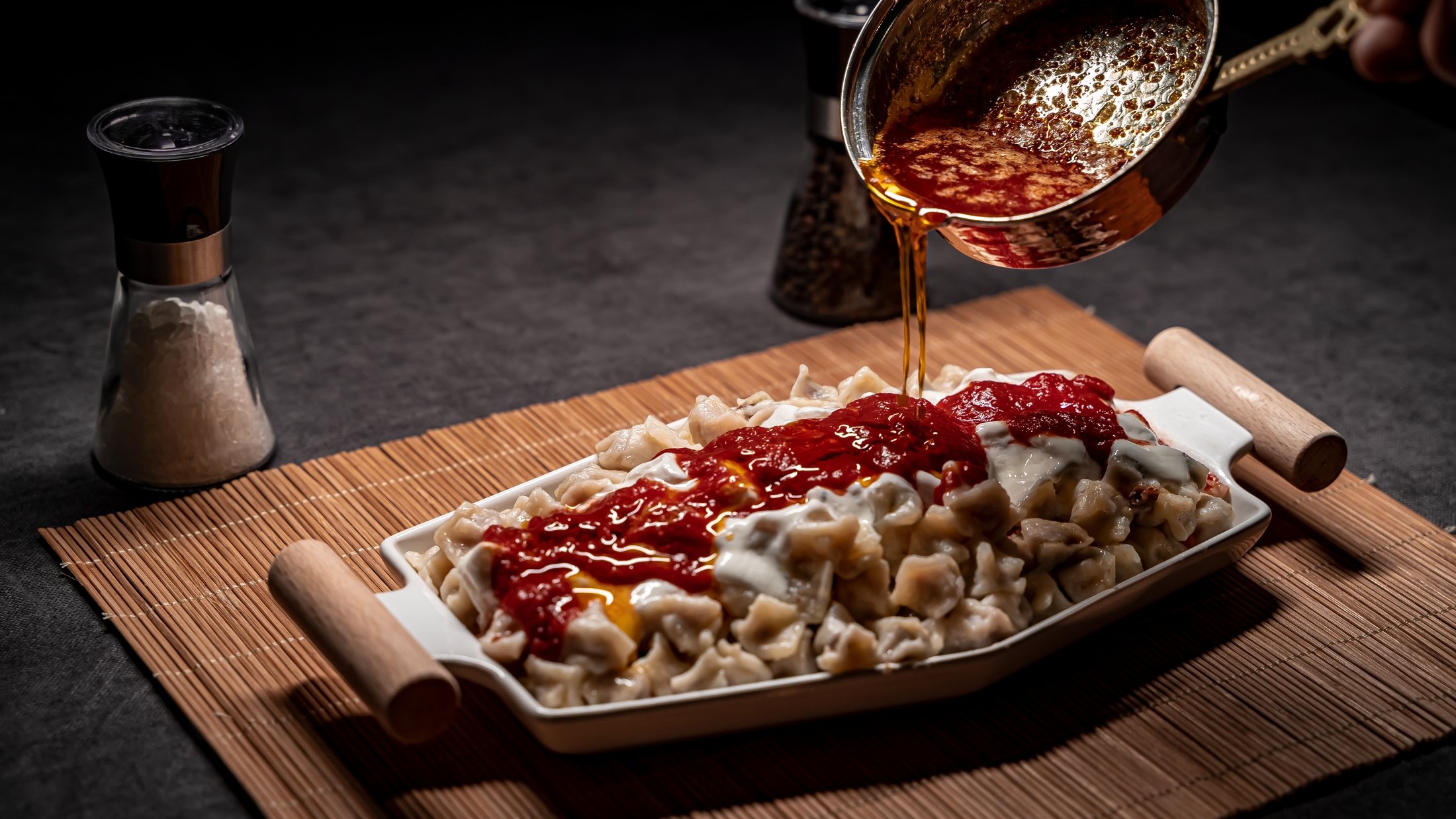
Have you ever tasted a dish that effortlessly blends comfort, history, and intricate flavor into tiny, satisfying bites, making you instantly understand why it is considered the queen of Turkish cuisine at every family gathering?
We are talking about Manti (Turkish Dumplings), a culinary masterpiece that traces its roots back to the nomadic tribes of Central Asia, evolving into the delicate, spiced pocket of joy beloved across Anatolia. Preparing authentic Turkish manti is indeed a labor of love, but let us assure you, the moment you taste the perfect combination of the thin, tender dough, the savory meat filling, the tangy garlic yogurt, and the sizzling butter sauce, you will know the effort was worth every second. This comprehensive guide will walk you through the secrets to creating this traditional dish, giving you the rhythm and technique necessary to master its preparation and impress everyone at your dinner table.
The Secret to Perfect Manti Dough
The true mark of authentic manti lies in its paper-thin dough, which should be delicate enough to almost melt in your mouth yet strong enough to hold the savory filling during boiling. We will begin with a simple yet precise mixture: all-purpose flour, eggs, a pinch of salt, and a minimal amount of water, often with a dash of olive oil for extra pliability. The magic is not just in the ingredients, but in the technique; combine the ingredients, starting with a fork and then moving to your hands, kneading the dough vigorously for at least ten minutes until it is smooth, firm, and elastic. Do not rush this step, as proper kneading develops the gluten, making the dough much easier to roll out thinly. After kneading, let the dough rest under a damp kitchen towel for a minimum of thirty minutes; this critical resting period relaxes the gluten, ensuring you can achieve that desired 1/16th-inch thickness, similar to a very thin pasta sheet.
Crafting the Savory Meat Filling
The filling for Turkish manti is traditionally simple, yet its flavor profile is incredibly deep, relying on a beautiful balance of meat, onion, and spices. You will typically use lean ground beef or lamb, although a combination of both is also acceptable for a richer taste. The key ingredient that sets the traditional Turkish filling apart is the finely grated or very finely chopped onion, which adds a crucial moisture and sweetness to the meat. We suggest using a proper ratio of roughly one medium onion for every pound of meat to achieve that classic flavor. Season the mixture minimally but effectively with salt, freshly ground black pepper, and often a touch of pul biber (Aleppo pepper flakes) for a gentle warmth. Remember, the filling is cooked inside the dumpling, so it must be mixed well but should remain moist and hold together in a small ball, about the size of a chickpea, when ready for assembly.
The Art of Folding: Tiny Parcels of Joy
This is where the real skill and dedication of manti-making shine through, particularly if you are aiming for the signature Kayseri mantısı size, which is known for its incredible smallness. Once you have rolled the dough out thinly, cut it into small squares, typically around 1.5 to 2 inches in size. Place a small, chickpea-sized portion of the meat mixture in the center of each square. The most common traditional fold involves bringing the four corners of the square together in the center and pinching the four edges firmly to seal the filling inside, creating a tiny, appealing pouch. The goal is to make these dumplings as small as you can; an old Anatolian saying suggests that the smaller the manti, the greater the skill of the cook. As you fold, lightly dust a baking sheet with flour and arrange the manti on it, ensuring they do not touch, to prevent sticking.
Regional Variations: Beyond the Boil
While the most common method is to boil the manti and serve it slightly drained, Turkish cuisine is rich with regional variations that offer delightful alternatives. For example, Sinop Mantısı from the Black Sea region often features the added texture and flavor of ground walnuts, which may seem surprising but is surprisingly delicious. The Tepsi Mantısı (Tray Manti) involves baking the dumplings in a shallow layer of broth or sauce, giving the dough a crispy, toasted bottom and a softer top, offering a unique crunchy texture. There is even a version called Yağ Mantısı (Oil Manti), popular in regions like Central Anatolia, where the dough is leavened, and the dumplings are deep-fried until puffy and golden brown, then served with the same yogurt and butter sauces. These variations prove that manti is a canvas for regional creativity, and we encourage you to explore these different forms once you have mastered the classic boiled version.
The Trio of Flavor: Sauce and Serving
The true soul of manti is the three-part serving ritual: the boiled dumplings, the cooling garlic yogurt, and the hot, spiced butter sauce, all culminating in a perfect bite. For the Garlic Yogurt Sauce, use thick, whole-milk plain yogurt or even a quality Greek yogurt, mince one or two cloves of fresh garlic, and stir it in with a touch of salt. This sauce should be tangy and cool to contrast with the heat of the main dish. Next, prepare the essential Spicy Butter Sauce: melt a generous amount of unsalted butter in a small pan, and as it begins to foam, stir in a spoonful of tomato paste or, for a more intense flavor, red pepper paste (biber salçası). Add pul biber (Aleppo pepper flakes) and dried mint, cooking just until the spices release their aroma, being careful not to burn the butter. To serve, ladle the cooked manti onto a warm serving dish, spoon a generous layer of the garlic yogurt over the top, and finish with a drizzle of the sizzling, fragrant butter sauce. For the final authentic touch, sprinkle with extra sumac, which adds a lovely tangy lift to the dish, and more dried mint.
Tips for Freezing and Pre-Preparation
Manti-making is a communal and time-intensive activity, and thankfully, the dumplings freeze beautifully, making it an excellent dish to prepare in bulk for quick future meals. After you have finished folding the dumplings, arrange them on a flour-dusted baking sheet, ensuring they do not touch, and place the entire sheet in the freezer. Once the manti are rock-hard and fully frozen, which usually takes an hour or two, transfer them to an airtight container or a sealed freezer bag. This prevents them from clumping together and allows you to cook only the amount you need later. When ready to eat, simply drop the frozen manti directly into a large pot of boiling, salted water, adding a few minutes to the cooking time compared to fresh manti; they should be tender in about twelve to fifteen minutes.
Cultural Context and Kitchen Practices
Preparing manti is not merely a cooking task; it is a deeply rooted cultural practice in Turkey, often bringing families together, especially for special occasions and large gatherings. The communal effort involved, from kneading the dough to the meticulous folding of hundreds of tiny pieces, fosters a wonderful sense of togetherness. While most of us do not have a full team to help, embracing the meticulous nature of the preparation is part of the experience. We highly recommend playing some traditional Turkish music and allowing yourself the time to truly enjoy the process, channeling the hospitality that this dish represents. As the esteemed editöründen of www.turkishrestaurant.ae often says, the effort you put into the manti is the love you taste on the plate, making every part of the creation significant.
Making Manti Your Culinary Signature
Mastering authentic Turkish manti gives you an impressive and incredibly satisfying dish to add to your repertoire, one that is truly beloved far beyond Turkey’s borders. Remember, the goal is always maximum flavor in the smallest package, and achieving that requires patience with the dough and precision with the folding. Once you have created your first batch of these delicate, bite-sized delights, you will have unlocked a piece of history and a core element of Turkish culinary tradition. Now, go gather your ingredients, knead that dough with purpose, and prepare to enjoy one of the world’s finest dumplings.
